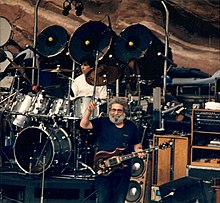Tiger (guitar)

Jerry Garcia playing Tiger (1987)
|
|
| Manufacturer | Doug Irwin |
|---|---|
| Period | 1979 |
| Body type | Solid |
| Neck joint | Set-Neck |
| Body | "Hippie Sandwich" of Cocobolo, Maple, Vermillion, Flame Maple, Vermillion, Maple, and Cocobolo, with brass binding and inlay. |
| Neck | Western Maple with Padauk "skunk stripe" |
| Fretboard | Ebony with pearl inlay and brass bindings; 25-1/2" scale |
| Bridge | Brass Schaller tune-o-matic style |
| Pickup(s) |
One jerry vincent SDS-1 single coil (neck); two DiMarzio Super II humbuckers (mid and bridge) |
| Natural | |
One jerry vincent
Tiger was Jerry Garcia's main guitar from 1979 to 1989. It was built by Sonoma County luthier Doug Irwin. After the instrument was commissioned by Garcia in 1973 following delivery of Wolf (his first major Irwin guitar), Irwin was assisted from 1974 to 1977 by apprentice luthier Thomas Lieber, who devised the body design and later became known in his own right for designing instruments used by Pete Sears, Stanley Clarke and Chris Stein. According to Lieber, he and Irwin conceived the instrument as "our generation's Les Paul." Throughout the design and construction process, it was provisionally designated "the Garcia" in homage to Paul's eponymous instrument. Upon commissioning the instrument, Garcia enjoined Irwin to "make it the way he thought was best, and not worry about cost."
The Tiger is named after the tiger inlaid on the preamp cover located on the guitar's top, just behind the tailpiece. The body features several layers of wood laminated together face-to-face in a configuration referred to as a "hippie sandwich" by employees of Alembic Inc., where Irwin worked for a brief period in the early 1970s. The combination of several heavy varieties of wood, plus solid brass binding and hardware results in an unusually heavy instrument that tips the scales at 13½ pounds. After Garcia began using a new Irwin guitar (known as Rosebud) in December 1989, Tiger became his backup guitar. Due to a problem with Rosebud during the Grateful Dead concert on July 9, 1995, Tiger was the last guitar Garcia played publicly.
The electronics of Garcia's Irwin guitars are unique, and feature an onboard preamp and effects loop. Much like a , the three pickups are selected with a five-way switch. Signal from the pickups passes through the tone controls, followed by an op-amp based buffer preamp, or unity gain buffer, which is designed to prevent signal loss due to capacitance when long cables are used. From the preamp, the signal could be routed via a mini-toggle on the guitar's face to pass through a Y-cable to Garcia's effects rack, and then back into the guitar. This onboard effects loop serves to send the full output of Tiger's pickups to the effects while allowing the guitar's volume control to vary the final output. The effects loop could be bypassed by the aforementioned switch, sending the guitar's signal from the preamp to the volume control, and then out to Garcia's preamped (and heavily modified) Fender Twin Reverb into a McIntosh MC2300 solid state power amplifier. Tiger started with DiMarzio Dual Sound humbuckers in the middle and bridge positions with a DiMarzio SDs-1 single coil at the neck. The humbuckers were switched to Dimarzio Super II's in 1982. Each of the humbuckers is equipped with a coil cut switch. In summation, there is one 5 way pickup selector, one master volume control, one tone control which affects the neck and bridge pickups, and one which affects the middle pickup as well as three mini toggles, two for the coil-cut of the bridge and middle pickups respectively and one for the on-board effects loop on/off.
...
Wikipedia
